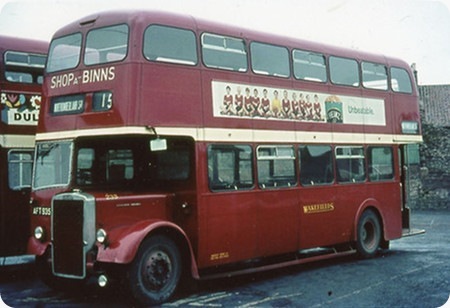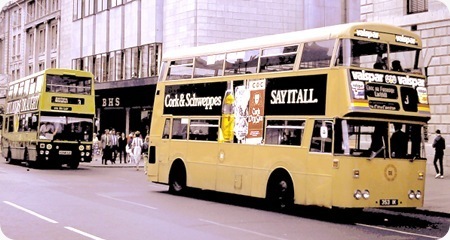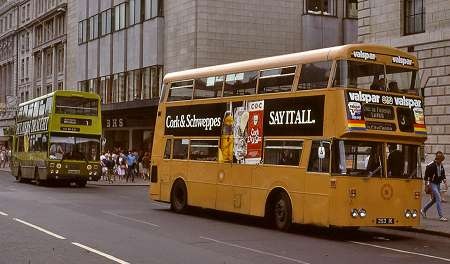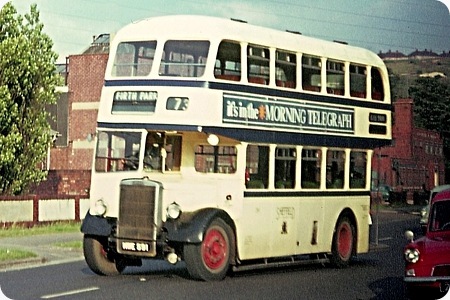
Copyright Ian Wild
Sheffield Corporation
1952
Leyland Titan PD2/12
Roe H33/25R
The recent posting of a Sheffield Mann Egerton bodied PD2 fleet number 362 provided some interesting information on new bus orders about that time and here is one of the Roe bodied PD2/12 ordered at the same time as the Mann Egerton pair. These were very elegant looking vehicles with deep windows in both saloons and I think looked especially handsome in the C T Humpidge era livery with three blue bands. Interesting to note how Roe incorporated a variation of the standard Sheffield destination layout – probably necessary because of the reduced depth available because of the afore mentioned deep windows. I well recall these buses replacing the Fulwood via Hunters Bar trams as the first programmed tram replacement scheme in January 1952. The new 88 bus route ran between the City and Fulwood with the City terminus being uniquely located in Eyre Street outside the Motor Vehicle Licensing Office (near the Central Library). This continued I believe until March 1954 when the 88 became a cross City service between Fulwood and Malin Bridge at the same time as the 81/82 bus routes replaced trams between Ecclesall and Middlewood.
Here is 391 in later life about to turn into Herries Road Depot on a summer evening in July 1967. The batch of nine were withdrawn the following year and 391 ended up inevitably with a Barnsley breaker.
Photograph and Copy contributed by Ian Wild
A full list of Titan codes can be seen here.
14/10/12 – 10:47
I am, of course, predisposed and prejudiced in this post. Magnificent body, excellent operator – and pretty good chassis!!! I never quite got to terms with the "heavy on blue" livery that all Roes were delivered in and generally preferred this scheme – which was always on repaint. Nevertheless, I also felt that these PD2s looked slightly bald in this scheme. Never actually rode on one and didn’t realise it was originally a City only service from Eyre Street. Only used the 60 to Crimicar Lane in my childhood – the 88 didn’t go up the hill!
David Oldfield
14/10/12 – 10:41
What I could never understand about the Sheffield fleet is this: all the views I have, bought ones or my own work relating to the bus fleet, show this style of livery. With the trams, however, and there are several preserved at Crich, if it was delivered in livery "A" it retained that livery throughout. If it was delivered in "B", it retained "B" throughout. Only the 1953 ‘Roberts’ trams had this style. Can anyone explain the apparent reluctance to modernise the livery on the trams, when it seems to have been done on the buses?
Pete Davies
15/10/12 – 07:32
Pete, you seem to have an inaccurate memory – or information – about Sheffield livery. This scheme was introduced in about 1936 for the Domed Standard (tram) Cars and extended to AEC Regent/Weymann buses. It was extended to all buses eventually, pre-war, including Craven and Leyland bodied TD5 Titans. The livery was perpetuated after the war on the Roberts trams – the only trams bought after the Domed Standards and, of course, the last "first generation" trams. It was also the standard bus livery except, for some inexplicable reason, all Roe deckers, Leyland Farington deckers and the final "not" Farington Leyland body (which were delivered in the short-lived and disastrous green experimental livery). The Roe and Leyland bodies had far more blue paint but most, if not all, Roes were painted in the scheme shown at first overhaul. Yet another superb colour shot by Ian.
David Oldfield
15/10/12 – 10:00
Thank you, David. The source of my information seems to be incorrect!
Pete Davies
15/10/12 – 17:22
The whole vehicle is pure and classic Roe, except for the front upper deck windows which look a little odd, the way that the top edge looks lower than the side windows. No doubt it’s just the evening sun shining on the white dome but it made me look twice, I thought some alteration had been done. Still a superb bus though!
Chris Barker
15/10/12 – 17:23
And don’t forget the variant of the grey roof, David, which buses tended to acquire on first repaint. I’ve heard it said that the grey was made up in Queens Road by mixing the dregs of the cream and blue paint tins, but I’m not sure how correct that is. I think the practice ended after Chaceley Humpidge became GM in 1961, as he wasn’t a fan of the grey roof. Personally, I think the ‘Farington’ PD2’s in their ‘Roe’ style livery looked better than ever with the roof painted grey.
Oddly enough, the domed roof trams that inaugurated the ‘new’ livery had a variation of the grey roof, or at least acquired one eventually; perhaps in wartime in an effort to make the cars less visible from the air? If the grey was in fact a combination of the blue and cream, perhaps it was a conscious effort on the part of the paint shop to not waste a drop!!
Dave Careless
16/10/12 – 05:29
Dave, you are absolutely correct about the grey paint – actually called "smudge". It gave a certain dignity to an already super livery. I do not know, and to my shame have not as yet bothered to find out, whether there was a policy about the smudge. My feeling is that it was applied before entry into service (whether or not by the coachbuilder or by STD) and lost on overhaul/repaint. I certainly feel that all the Weymanns (classic and Orion alike) on 26′ and 27′ chassis entered service with smudge roofs. The Domed cars probably likewise.
David Oldfield
16/10/12 – 11:45
I don’t know whether there was a wartime edict to paint bus roofs a less obtrusive colour . LPTB went from silver to grey to brown quickly. However, the dirt falling onto tram and trolleybus roofs from poles and wiring might well have been a consideration not to change back later.
Chris Hebbron
16/10/12 – 16:52
Grey roof painting was widely adopted on the outbreak of WW2. It was kept by many operations for a long time afterwards. For instance Manchester had its 1946 deliveries painted in this manner. When it converted its orders to 8′ wide vehicles they appeared with red roofs, the 7′ 6" vehicles retained the grey so the bus washers knew how to set washer width. Few 7’6" vehicles appeared in the "overall" red scheme but by that time the washers set themselves automatically.
Stockport cut back its grey from 1946 but retained the centre of the roof in grey for all deliveries up to and including the first batch of St Helen’s fronted PD2s in 1962. Frank Brimelow specified translucent roofs thereafter but all re-sprays of grey roofed vehicles received the grey until SELNEC took over.
Phil Blinkhorn
17/10/12 – 08:30
On the subject of grey or other colour for the roof, one of my former colleagues was a descendent of B C Baker of Birmingham City Transport. Birmingham had a sandy colour for their bus roofs, apparently as camouflage. My colleague suggested it was to confuse the Afrika Corps!
Pete Davies
17/10/12 – 08:31
This bus and its windows is reminiscent of Roe’s 8ft Doncaster 121 and 122 which were sold to Blue Ensign after 4 years because either they didn’t fit the streets (official) or the washer (Tony Peart). Did they also have the cranked seats and "high level" rear platform? It seems that Roe had a sudden urge to innovate…?
Joe
17/10/12 – 11:24
No, Joe, that was a Doncaster thing. The vehicles you mention are closer to STD 18/19; 113-119 – the 1952 four bay bodied Regent IIIs (my equal favourite with 1325 – 1349). Incidentally, Charles Halls has these PD2s (386 – 394) as 1951 and 361/2 (the Mann Egertons) as 1952. I always took this to be correct and that the Roes were late ’51 and the Mann Egertons early ’52.
David Oldfield
17/10/12 – 18:04
One further thought with respect to Sheffield’s penchant for grey roofs, a style that became a thing of the past after C.T. Humpidge took over. It occurs to me that it must have seemed a bit like déjà vu to the new General Manager when he got settled into the chair at Sheffield in 1961.
Bradford’s fleet had grey roofs into the early 1950’s, when he took over the top job in that city, after which the roofs on the buses eventually became blue on his watch. When he took over the reins at Sheffield, and saw the tins of "smudge" on the shelves at Queens Road, he must have felt he was starting all over again!
Dave Careless
18/10/12 – 07:46
The Fulwood via Hunters Bar tram route that these buses took over from was converted to bus operation (service 88) on 5th January 1952 so this batch would almost certainly have been delivered in late 1951. I can only recall one Sheffield bus with cranked seats and this was all Leyland 651 of the 1949 batch (and then I think the lower deck only). Can the Sheffield people out there confirm this and what was the reason?
Ian Wild
18/10/12 – 10:44
Chieftain Buses of Hamilton acquired a second-hand ex-Sheffield TD5 Craven in the late 40s. BWB ###. The engine in this bus sounded different to any other TD5 I had come across. It surely could not have been a petrol engine? Any enlightenment?
Jim Hepburn
18/10/12 – 14:37
Leeds had one AEC Regent with staggered seats 700 NUM 700 a 1950 show exhibit which was LCTs second 8ft wide bus I have a vague feeling that these were removed and replaced with normal seating towards the end of its LCT life.
Chris Hough
19/10/12 – 06:32
The Sheffield livery variation on the Roe bodied vehicles has long been a talking point. The whole process was caused by the changes to the Leyland Farington PD2/1’s delivered in 1949. The mouldings below the lower deck windows were discontinued, along with upper beading. Leyland asked for a simplified livery in lieu of cream and three blue bands, for the high cost of lining out would be excessive.
AEC Regent Weymann FWJ 808 was used to trial a simpler paint style.
With a slight modification,this livery was adopted for the large intake of Farington PD2’s.
When the Roe order for PD2/12’s was placed, a similar situation resulted. The narrow lower deck waist rail would have unbalanced the lower deck blue band proportions, therefore a decision was made to adopt the Farington style. The new GM C.T.Humpidge took a dislike to the Roe livery in 1962 and repaints received the standard livery in due course. Remarkably, none of the Farington fleet were so changed in livery style.
Keith Beeden
24/11/12 – 06:50
Referring to Jim Hepburn’s post of 18th October, as the BWA to BWE range of registrations was limited to 1935, I would imagine that the vehicle he refers to would be a Leyland TD4C/Cravens which used the torque converter rather than a convention gearbox and was commonly known as ‘Gearless Bus’. The sound produced, as I remember, from like vehicles surviving into the 50’s resembled a long monotonous droning noise especially from a standing start.
Just to add to David Oldfield’s response to Pete Davies on the subject of liveries. For Pete to understand that trams delivered in Liveries A or B would retain that livery throughout is erroneous. Following the standardisation of Azure Blue and Cream circa 1936, numerous older trams previously wearing the Prussian Blue and Cream were repainted into the Azure Blue livery. In fact, one such tram, namely 150, delivered in Prussian Blue in 1930 was repainted into the ill-fated Green livery in 1952 and then Azure Blue shortly afterwards.
As regards the subject of the post, PD2 No. 391, my humble opinion is that it looks absolutely dreadful in the Humpidge interpretation of the standard livery. As Keith Beedon has explained, the Farrington style livery was applied to the Roe designs for good reason and looked nicely balanced on these elegant vehicles. The painting out of the dividing bar on the front destination box just added to the desecration but credit is due for restoring the cream roof. I would refer all to C.C.Hall’s ‘Sheffield Transport’ Page 263 to see just how superb 389 of the same batch looked when new. (I’m sure many of you will have this book but if not and you are ‘Up North’, there is a copy in the splendid ‘Search Engine’ Reference Library at the National Railway Museum at York)
John Darwent
18/12/12 – 17:37
Referring to Ian Wild’s post of 18-10-2012, Keith Beeden advises that Sheffield all Leyland 651 was fitted with cranked seats on both decks. These were supplied by Siddall and Hilton. Here is an extract from Commercial Motor of 8th December 1950- Article titled Innovation Components and Accessories
"More room with less seat" is the object of the new Sidhil-Morseat, manufactured by Siddall and Hilton, Ltd.. Sowerby Bridge, Yorks. Employing a cleverly cranked frame, this service-bus seat enables two passengers to sit comfortably side by side without encroaching on each other or on the gangway.
The outer half of the seat, apart from being set back, as in a normal cranked seat, is also turned slightly inward, so that the "gangway" passenger’s elbows are out of the way of the inside" passenger. A recess in the centre of the seat provides additional elbow-room, enabling both passengers to get at pockets for their fares without the usual difficulty.
Further, each person enjoys the full width of backrest and the "inner" passenger can more easily leave his seat without disturbing his neighbour. With this design, the conductor can move more easily about the bus, and is able, with less difficulty, to collect the fares from the window-side passenger.
John Darwent
19/12/12 – 07:29
Siddall & Hilton are still in business today in Halifax producing wire products, hospital beds and other ancillary equipment for the healthcare industry.
Eric Bawden
03/08/13 – 14:25
Long time since I visited this site , but thanks to John Darwent for info. on BWB Craven. By this time, it had a conventional gearbox but still sounded unusual.
Now another ex. Sheffield bus was WJ 9094. Any info.?
Jim Hepburn
04/08/13 – 10:40
WJ 9094 was a Leyland TD3c, fleet number 94, Cravens H31/24R. Arrived 1934, withdrawn 1941. Think chassis number was 3606.
Les Dickinson
06/08/13 – 06:05
Thanks Les about info. on TD3c WJ 9094. This bus was converted to a conventional gearbox and served with J. Laurie`s of Hamilton`s "Chieftain" buses plying between Hamilton and East Kilbride, and was not withdrawn till 1954.
Jim Hepburn
 Vehicle reminder shot for this posting
Vehicle reminder shot for this posting
14/10/13 – 08:09
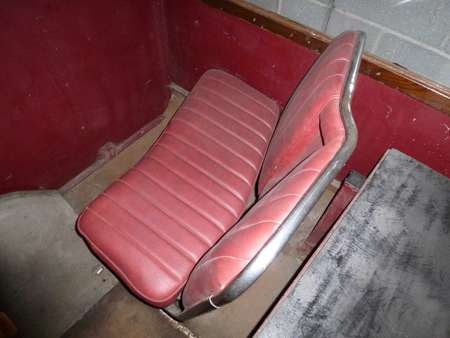
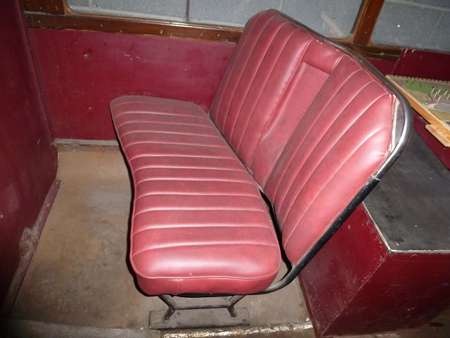
Referring to my post of 18-12-12 about the cranked seats in Sheffield PD2 No. 651, I have now had the opportunity to photograph probably the last pair of ‘Sidhil’ Morseats in captivity which are currently in Sheffield AEC/MCW ex 255, now preserved as ex-gritter G55 in the South Yorkshire Transport Museum at Aldwarke, Rotherham.These seats were the spare pair supplied with 651 and retained by Sheffield Transport Department after the bus was sold on.
John Darwent
15/10/13 – 07:08
Not quite the last set in captivity!. Doncaster 122, the beautiful AEC Regent 111/Roe restored by the late Tony Peart has these seats as well.
Andrew Charles
15/10/13 – 18:03
Splendid news Andrew, thank you for posting. Has 122 a full set, upstairs and downstairs, do you know? I wonder if any more are lurking in preservation.
John Darwent
